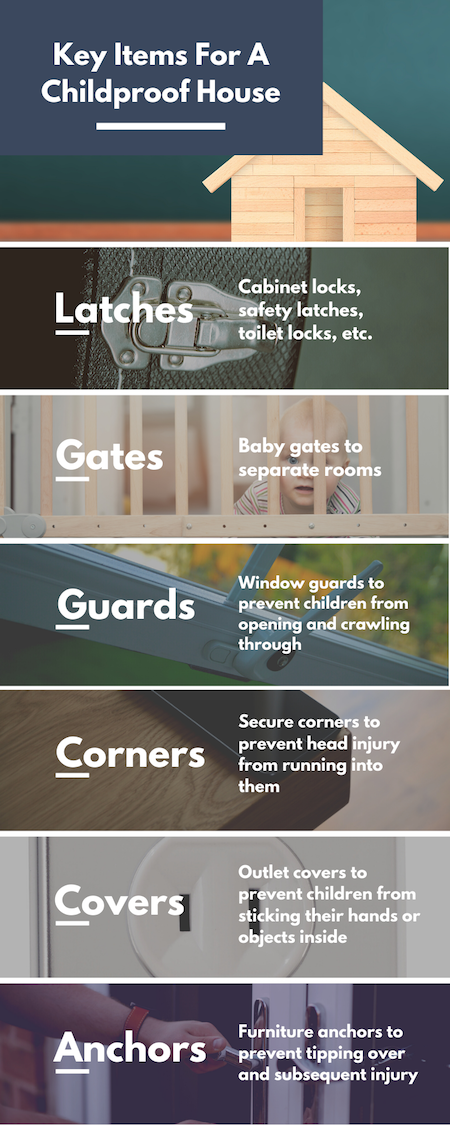How to Childproof a Home: Step by Step Guide
One of the most important parts of preparing for a new baby in the house is to make sure the house is completely childproof, meaning the house is completely free of hazards that a baby or developing child could accidentally get themselves into. If we’re being honest, this can be a harder task than you think. Depending on how large your house is, it could seem like there’s just so much to fix, and you don’t really know where to start. Luckily, we’ve provided a guide below that goes room by room and offers insight on everything you need to be cautious of. One of our biggest tips to offer is if you don’t completely know what to look for, it helps to literally get down on a child’s level and see the world from their view.
The Baby’s Room- As you can probably guess, your child’s room is the most important room to childproof before you begin exploring other parts of the house. Simple changes around the room can be effective at keeping your child safe.
- Use a firm crib that doesn’t dip when the baby placed inside, with no toys, decorations, or stuffed animals.
- Your baby’s changing table should have three raised sides and includes a restraining strap.
- The slats on the baby’s crib should be narrow enough that they won’t be able to wiggle through or get stuck.
- Use a toy box that has a light, gentle lid. A lid that is heavy can accidentally fall on your child.
- Use soft carpet or a soft rug on the floor to keep your child safe from accidental falls.
- Keep your water heater set at 120 degrees. This prevents the possibility of burns in the bathtub.
- Buy toilet locks that keep your child’s head away from accidentally falling into the toilet bowl.
- Unplug and safely store heat appliances, like hairdryers, curlers, and flat irons.
- Use a non-slip bathroom mat in the bathtub and on the floor.
- Safely store away your medication and make sure it has a child-safe lock on it.

- Use childproof latches on any drawers your child could reach that contain things like scissors, knives, or matches.
- If you have appliances on the counter, make sure they’re placed far out of reach without their cords hanging off the side.
- Always unplug your appliances after using them.
- Invest in a sturdy high-chair that uses seatbelts and crotch straps.
- Use covers, locks, and shields on your oven and stove to prevent your child from being able to turn the oven.
- Whenever you use the stove, use the back burners to prevent accidental burns, and keep stove handles turned inward so that your child cannot grab them.
- IMPORTANT: Make sure to remove any refrigerator magnets that could be a choking hazard to your child.
- Try not to use tablecloths, children seem to love to pull on them.
- Put covers on the edges of tables to avoid your child accidentally hitting their head on it.
- Try to keep cords behind furniture or otherwise hidden from your child’s view.
- If you plan on having a plant, make sure it’s not toxic if ingested.
- Secure any furniture that could fall on your child to the wall.
- Secure TVs and other items on tables to the table itself to prevent it from falling.
- Make sure cleaning supplies have a childproof lock on them and keep them behind cabinets with locks on them as well.
- Don’t use stairs that have railings with slats in them. Your child could stick their head through the spaces and get stuck.
- Use carpeted stairs in case your child falls.
- Keep all walkways clear of small items like bags, toys, or especially balloons.
- Install locks on the windows that limit how far you can open the window.
- Make sure you have a smoke detector, carbon monoxide detector, fire extinguisher and fire blanket in the house.
- Have 911 speed dialed on your house phone if you have one and make sure your child understands how to call 911 in case of an emergency.
- Use safety gates to prevent your child from getting into certain rooms when they shouldn’t be in there.
- Use outlet covers to keep your child from sticking fingers or items inside. They could accidentally get electrocuted.
- Keep buckets and bins turned over so they can’t collect water. Your child can drown in small amounts of water.
- In the garage, make sure your vehicle is locked at all times.
- Keep your washer and dryer locked so your child cannot climb into it.
- Keep any cosmetics away from your child’s reach. They might try to put products in their mouth or choke on a small object.
Childproofing can be hard work, but it’s well worth taking the time to do it so your child can be as safe as possible. After you’ve gone through your house, do a double-check and skim all the rooms again in case you’ve missed something. In fact, every time you clean the house, make sure you’re keeping your child in mind. Layouts of the house can change over time, and you may need to occasionally update your childproofing techniques.

